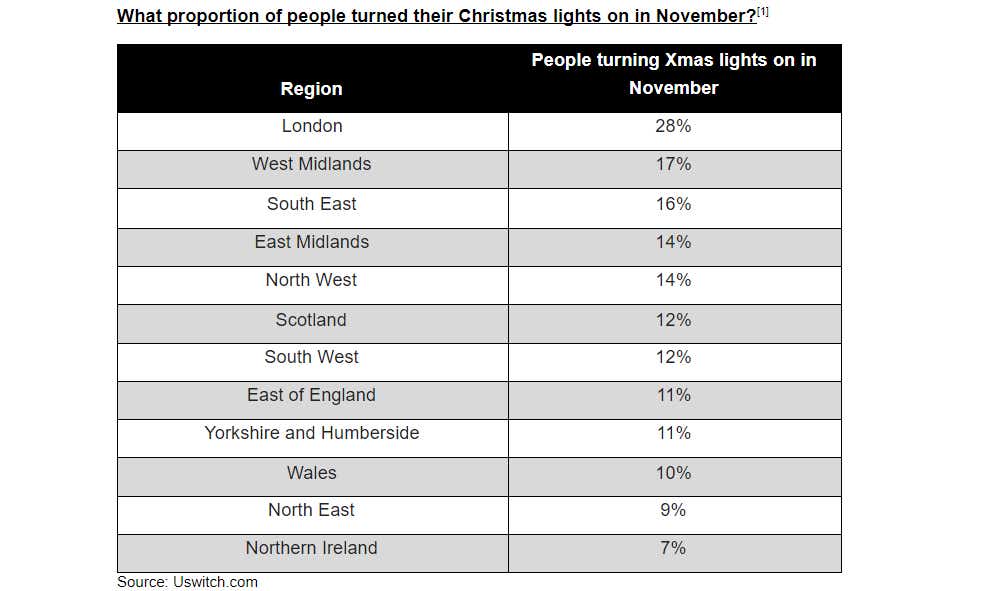Four million homes have already put up their Christmas lights[1], with three in five (59%) people saying they wanted to brighten up lockdown[2]
Most consumers turned on their festive lights on 26 November[1] — five days earlier than the conventional 1 December switch-on
Households say they will keep their lights on for an extra four days this year, turning them off 7 January[1] — a day later than last year
The average display costs £52[3], but could add £79 million to the energy bills of the seven million people with displays[4]
One in six households (15%) has had a disagreement with neighbours over displays, with almost half (44%) falling out because lights ‘looked tacky’[5]
With two in five (39%) households not checking the power consumption of lights[6], Uswitch.com calls on consumers to look at energy efficiency labels before they buy.
Christmas has come early for the four million homes who put up their festive lights in November[1], according to new research by Uswitch.com, the comparison and switching service.
The most common date for households to turn on their Christmas lights was 26 November this year[1] — five days earlier than the conventional 1 December switch-on.
Many people turned their lights on in November due to the new Covid-19 measures, with three in five (59%) of the early birds saying they used their displays as a way to brighten up lockdown[2].
Households are planning to keep their lights on for an extra four days this year, with 7 January set to be the average date that displays will come down, a day later than last year[1].
People spend £52 on average on their outdoor light display[3], which typically has more than two types of decorations, with fairy lights being the most common illumination. Surprisingly, glowing reindeers are a more popular installation than Santa or snowmen[7].
Many households are cavalier about the energy costs of running lights for the full 43-day festive period, with only two in five (39%) checking the power consumption or energy efficiency of lights before they buy[6].
A household with 200 fairy lights and a light-up reindeer could expect to add £11 to their energy bill if they ran their decorations for six hours a night from November 26 to January 7. With seven million people having outdoor light displays, the nation’s Christmas illuminations bill would be £79 million[4].
However, those using newer, more energy efficient LED lights would increase their bills by only £1.10 over the same period. If the whole country switched to LED lights, the UK’s bill would only be a tenth of the size, at £7.9 million[4].
Londoners were the first to turn their Christmas lights on, with more than a quarter (28%) doing so in November. However, only 7% of households in Northern Ireland decided November was the best month to put their lights up[1].

Although the vast majority of people (77%) said they like Christmas light displays[8], that hasn’t stopped almost a sixth of households (15%) getting into disagreements with their neighbours[5].
The main reason for raised voices over the garden fence was because a display ‘looked tacky’, with this causing 44% of disputes[5].
Sarah Broomfield, energy expert at Uswitch.com, comments:
“Many of us have already seen Christmas displays going up in our streets as people put their lights on in November to brighten the dark days of lockdown.
“The big displays can look very impressive, but they can also dramatically increase energy consumption, particularly if they are using old, non-LED lights.
“If you are planning to buy some lights, it is always worth checking the labels to see how much energy they use.
“LED lights are very energy efficient, and will help to prevent you starting your new year with a nasty surprise on your energy bills.”
Find out how you could save nearly £1,000 a year with Uswitch here.
FOR MORE INFORMATION
Ross Stebbing
Phone: 07827 836 709
Email: ross.stebbing@rvu.co.uk
Twitter: @UswitchPR
Notes to Editors
Research conducted online by Opinium, 20 November to 23 November 2020, among 2,000 adults, weighted to be nationally representative.
1. Respondents who celebrate Christmas and will put lights up were asked ‘When did you/will you turn on your lights this year?’ 22% said November. Average date was November 26. Respondents who also asked ‘When will you take your Christmas lights down?’ Average date was January 7. Respondents were asked ‘When did you take your Christmas lights down last year?’ Average date was January 6.
2. Respondents were asked ‘You mentioned you have/will turn on your Christmas lights earlier this year compared to last year, what are your reasons for doing so?’ 59% said to ‘brighten up lockdown 2.0’.
3. Respondents were asked ‘Thinking about all the lights you will have this Christmas, what was the total cost of purchasing each type?’ Average cost for external lighting was £52.20.
4. LED lights for outside = 0.1W per bulb. A 200-bulb display = 20W. Light-up reindeer = 6W. Energy Saving Trust estimates an average electricity price of 16.36p per kWh. 16.36p x 0.026 x 6 hours a day x 43 days = 109.74 pence = £1.10 to run LEDs. 25% have outdoor lighting. 25% of 27.6 million = 7.15 million people having displays costing £7.85 million. LEDs use 10% of the energy of non-LED lights. Cost is £78.5 million electricity if everyone uses non-LED lights.
5. Respondents who celebrate Christmas were asked ‘Have you ever had issues with a neighbour over a Christmas lights display?’ 15% said yes. 44% of those who said yes said the issue was over their display or a neighbour’s display ‘looking tacky’.
6. Respondents who have lights were asked ‘When shopping for Christmas lights, do you check the power consumption or look for energy-efficient lights?’ 39% said no.
7. Respondents who plan to have lights up this year were asked ‘How many of the following decorations will you have outside your property this year?’ 60% said fairy lights. Of light-up creatures and figures, 12% said reindeers, 11% said snowman, 11% Santas, and 8% said polar bears.
8. Respondents were asked ‘Which of the following best describes how you feel about Christmas light displays outside people’s homes?’ 77% said they like them.
About Uswitch
Uswitch is one of the UK’s top comparison websites for home services switching, including energy, broadband and mobiles.
More people go to Uswitch to switch their energy, broadband and mobile than any other site, and we have saved consumers over £2.7 billion off their bills since we launched in September 2000.
Free mobile app Utrack also helps households manage their home energy usage and make potential savings.
Uswitch is part of RVU, a group of online brands with a mission to empower consumers to make more confident home services, insurance and financial decisions.
